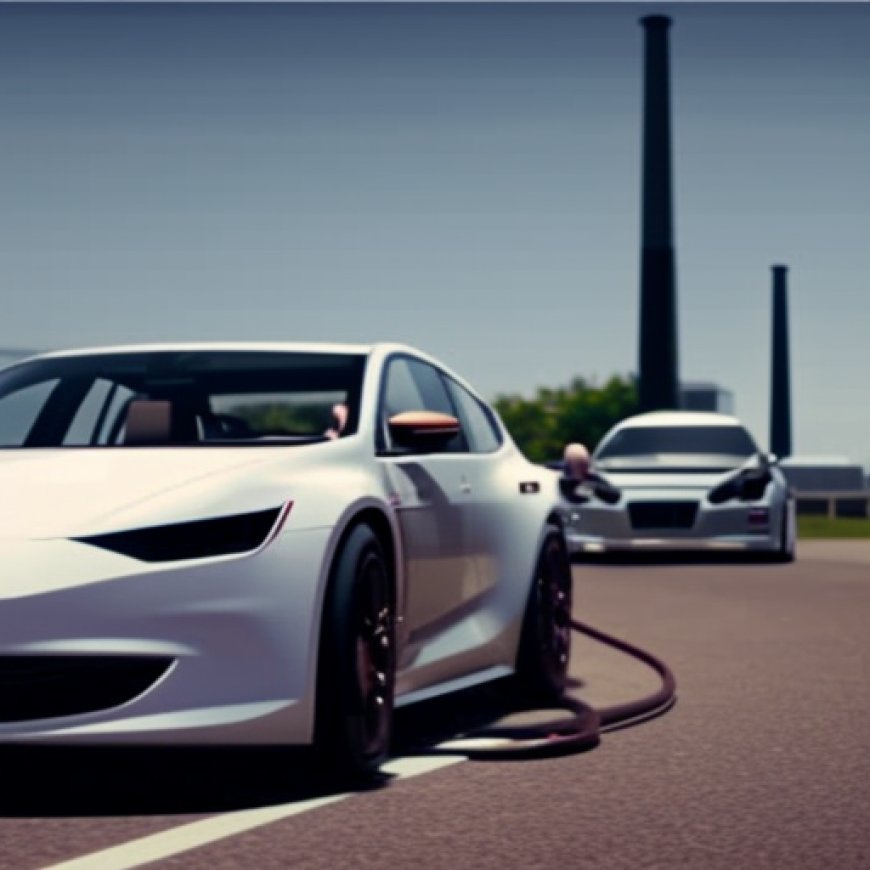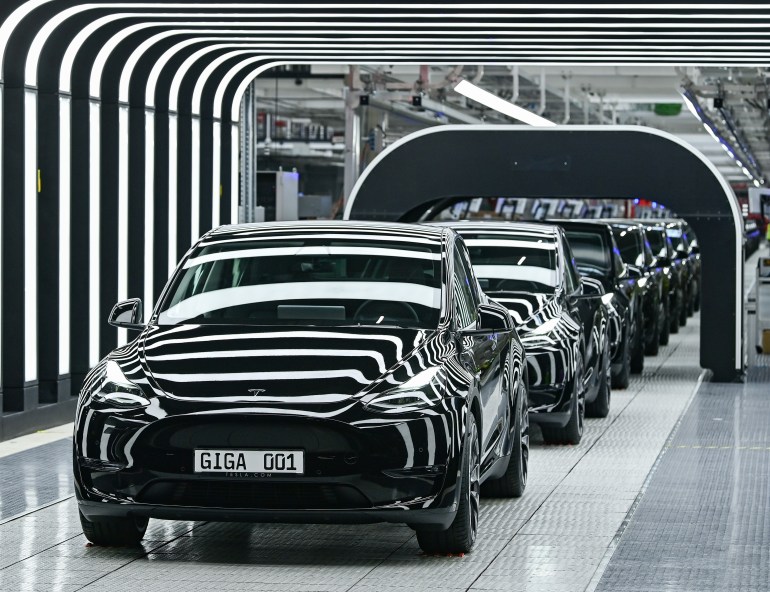Is the race for ‘clean’ electric vehicles destroying communities?
Land grabs and vanishing forests: Are ‘clean’ electric vehicles to blame? Al Jazeera English


Sustainable Development Goals and the Environmental Impact of Electric Vehicles
As the world increasingly prioritizes the transition to renewable energy and sustainable technology, the popularity of electric vehicles (EVs) has soared. However, rights groups are now raising concerns about the environmental damage and harm to local communities caused by the growth of the EV industry in Indonesia, the Philippines, and the Democratic Republic of the Congo (DRC).
The demand for EVs has significantly increased in recent years, with electric cars accounting for 14 percent of total car sales in 2022, up from just 4 percent in 2020. This surge in popularity can be attributed to heightened environmental awareness and a wider range of EV options available to consumers.
The Environmental Impact of the EV Industry
The transport sector has long been a target for environmental activists due to its contribution to global carbon emissions. While EVs are often hailed as a solution to this issue, reports from rights groups have revealed a dark side to the industry.
In Indonesia and the Philippines, where the largest nickel deposits in the world are found, the increase in mining of nickel – a crucial material for EV batteries – has caused environmental damage and harmed local communities. Similarly, mining of cobalt and coltan, also important for EVs, in the DRC has raised concerns about displacement of communities and unethical mining practices.

How are communities being harmed?
According to Climate Rights International (CRI), residents living near nickel mining sites in Indonesia’s Halmahera island have reported coercion and intimidation by mining companies operating in the Indonesia Weda Bay Industrial Park (IWIP). These companies collude with the police to force landowners to sell their land without compensation, leading to displacement and loss of livelihood for many community members.
Furthermore, large areas of forests are being cleared for mining, resulting in increased carbon emissions. Indigenous communities, such as the O Hongana Manyawa in the IWIP area, are at risk of losing their homes due to ongoing deforestation.
Working conditions in these mining areas are also poor, as evidenced by a deadly explosion at a nickel plant in Sulawesi Island. Additionally, polluted water from the mining park is contaminating local water sources, affecting fishermen and forcing them to venture further out to sea for clean water.
Why is nickel so important?
Nickel has traditionally been used in the production of stainless steel and car components. However, the demand for nickel has surged with the rise of renewable technologies, particularly EVs. Nickel is a key component of lithium-ion batteries used in electric vehicles. Between 2010 and 2020, global demand for nickel grew by 41 percent.
Indonesia, the largest producer of nickel, has positioned itself strategically for an EV-driven world. The country has enforced policies banning nickel ore exports and has attracted significant investment from mining companies. The IWIP, a joint venture between Chinese companies and Indonesian partners, is one of several nickel processing parks being developed in Indonesia.
Which other countries are affected?
The Philippines, the second-largest producer of nickel, has also faced concerns about unethical mining practices. Amnesty International reported violations of labor laws and poor working conditions in nickel mining projects on the Dinagat Islands.
In the DRC, the mining of cobalt and coltan, which are crucial for rechargeable batteries, has led to the displacement of communities. Chinese companies, in partnership with state mining corporations, are extracting minerals in the DRC.
What action is being taken to counter these issues?
Official action to address these issues has been limited. Advocacy groups in Indonesia have been protesting and lobbying against the IWIP mining project, but it is unlikely that mining and refining processes will be halted.
Climate Rights International recommends government intervention to cease intimidation tactics, strengthen laws protecting local communities, clean up polluted water sources, compensate affected communities, and transition to renewable energy.
In the DRC, initiatives have been established to trace and verify supply chains of minerals like cobalt and coltan. However, investigations have revealed that conflict minerals and those sourced from mines using child labor still enter global supply chains.
While some EV manufacturers, such as Tesla, have been indirectly implicated in these issues, there is a need for responsible sourcing and reduced reliance on fossil fuels across the industry.
Efforts to address these challenges align with several Sustainable Development Goals (SDGs), including SDG 7 (Affordable and Clean Energy), SDG 8 (Decent Work and Economic Growth), SDG 12 (Responsible Consumption and Production), and SDG 13 (Climate Action).
SDGs, Targets, and Indicators
| SDGs | Targets | Indicators |
|---|---|---|
| SDG 7: Affordable and Clean Energy | Target 7.2: Increase substantially the share of renewable energy in the global energy mix | No specific indicators mentioned in the article |
| SDG 8: Decent Work and Economic Growth | Target 8.7: Take immediate and effective measures to eradicate forced labor, end modern slavery and human trafficking, and secure the prohibition and elimination of the worst forms of child labor | No specific indicators mentioned in the article |
| SDG 9: Industry, Innovation, and Infrastructure | Target 9.4: Upgrade infrastructure and retrofit industries to make them sustainable, with increased resource-use efficiency and greater adoption of clean and environmentally sound technologies and industrial processes | No specific indicators mentioned in the article |
| SDG 12: Responsible Consumption and Production | Target 12.2: By 2030, achieve the sustainable management and efficient use of natural resources | No specific indicators mentioned in the article |
| SDG 13: Climate Action | Target 13.3: Improve education, awareness-raising, and human and institutional capacity on climate change mitigation, adaptation, impact reduction, and early warning | No specific indicators mentioned in the article |
| SDG 15: Life on Land | Target 15.2: Promote the implementation of sustainable management of all types of forests, halt deforestation, restore degraded forests, and substantially increase afforestation and reforestation globally | No specific indicators mentioned in the article |
1. Which SDGs are addressed or connected to the issues highlighted in the article?
- SDG 7: Affordable and Clean Energy
- SDG 8: Decent Work and Economic Growth
- SDG 9: Industry, Innovation, and Infrastructure
- SDG 12: Responsible Consumption and Production
- SDG 13: Climate Action
- SDG 15: Life on Land
2. What specific targets under those SDGs can be identified based on the article’s content?
- Target 7.2: Increase substantially the share of renewable energy in the global energy mix
- Target 8.7: Take immediate and effective measures to eradicate forced labor, end modern slavery and human trafficking, and secure the prohibition and elimination of the worst forms of child labor
- Target 9.4: Upgrade infrastructure and retrofit industries to make them sustainable, with increased resource-use efficiency and greater adoption of clean and environmentally sound technologies and industrial processes
- Target 12.2: By 2030, achieve the sustainable management and efficient use of natural resources
- Target 13.3: Improve education, awareness-raising, and human and institutional capacity on climate change mitigation, adaptation, impact reduction, and early warning
- Target 15.2: Promote the implementation of sustainable management of all types of forests, halt deforestation, restore degraded forests, and substantially increase afforestation and reforestation globally
3. Are there any indicators mentioned or implied in the article that can be used to measure progress towards the identified targets?
No specific indicators are mentioned in the article that can be used to measure progress towards the identified targets.
4. Table: SDGs, Targets, and Indicators
| SDGs | Targets | Indicators |
|---|---|---|
| SDG 7: Affordable and Clean Energy | Target 7.2: Increase substantially the share of renewable energy in the global energy mix | No specific indicators mentioned in the article |
| SDG 8: Decent Work and Economic Growth | Target 8.7: Take immediate and effective measures to eradicate forced labor, end modern slavery and human trafficking, and secure the prohibition and elimination of the worst forms of child labor | No specific indicators mentioned in the article |
| SDG 9: Industry, Innovation, and Infrastructure | Target 9.4: Upgrade infrastructure and retrofit industries to make them sustainable, with increased resource-use efficiency and greater adoption of clean and environmentally sound technologies and industrial processes | No specific indicators mentioned in the article |
| SDG 12: Responsible Consumption and Production | Target 12.2: By 2030, achieve the sustainable management and efficient use of natural resources | No specific indicators mentioned in the article |
| SDG 13: Climate Action | Target 13.3: Improve education, awareness-raising, and human and institutional capacity on climate change mitigation, adaptation, impact reduction, and early warning | No specific indicators mentioned in the article |
| SDG 15: Life on Land | Target 15.2: Promote the implementation of sustainable management of all types of forests, halt deforestation, restore degraded forests, and substantially increase afforestation and reforestation globally | No specific indicators mentioned in the article |
Behold! This splendid article springs forth from the wellspring of knowledge, shaped by a wondrous proprietary AI technology that delved into a vast ocean of data, illuminating the path towards the Sustainable Development Goals. Remember that all rights are reserved by SDG Investors LLC, empowering us to champion progress together.
Source: aljazeera.com

Join us, as fellow seekers of change, on a transformative journey at https://sdgtalks.ai/welcome, where you can become a member and actively contribute to shaping a brighter future.







